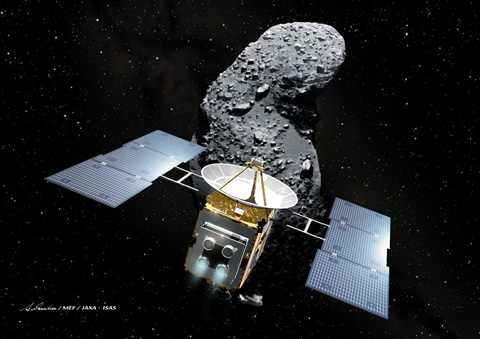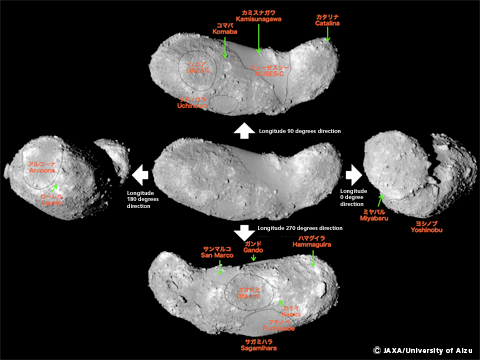Official Approval of Names on ITOKAWA by IAU
Japan Aerospace Exploration Agency (JAXA)
The Japan Aerospace Exploration Agency (JAXA) requested the International Astronomical Union (IAU) approve 14 names of craters and places on the surface of the asteroid "ITOKAWA," where our Asteroid Explorer "HAYABUSA" carried out scientific observations. The application was submitted under the theme of "place names concerning space development and asteroid science."
On February 19, 2009 (Japan Standard Time,) the names were approved by the IAU, thus they can be used as official names. We thoroughly discussed the names with the IAU's Working Group for Planetary System Nomenclature, and all our proposed names were accepted. This was the first time that Japan requested the approval of such a large number of names for the surface of an asteroid and all of them were accepted at once.
It was also the first time that such a number of Japanese names were christened on the surface of an asteroid.
The names were decided in corporation with the University of Aizu, which studies the topology on the surface of the ITOKAWA based on observation data.
|
|
(Reference: Names of astronomical bodies and names of places on astronomical bodies)
Names of astronomical bodies and places on them in the solar system are important information as a basis for discussion among researchers. Therefore, the International Astronomical Union (IAU) functions as the sole organization to manage and administrate the names. When a new name is given, a working group in the IAU carefully examines the application submitted by the discoverer of a new astronomical body or the place on it to study if the name clearly indicates its geographic features, the scientific importance and appropriateness of the reasons for naming. In addition, the group reviews if that name already exists. After a thorough review, the name is approved, and can be officially used. With the approval of the names, further research on the ITOKAWA is expected to progress as we look to share our knowledge about the ITOKAWA with the world.Table 1: Names on ITOKAWA and where they come from
Crater names| Names | Originated from | |
|---|---|---|
| 1 | Catalina | The name of an astronomical observatory in Arizona, USA. |
| 2 | Fuchinobe | A place name in the city of Sagamihara, Kanagawa, Japan. It is also a train station name closest to the JAXA Sagamihara Campus, the center of the HAYABUSA's development and operation. |
| 3 | Gando | The name of a rocket launch site in the Canary Islands, Spain. |
| 4 | Hammaguira | The name of a French rocket launch site that used to exist in the Sahara Desert (Algeria.) |
| 5 | Kamisunagawa | A town name in Sorachi-gun, Hokkaido, Japan, where test equipment for microgravity exists. |
| 6 | Kamoi | A place name in the city of Yokohama, Kanagawa, Japan, where a business office of NEC TOSHIBA Space Systems. Ltd., which is a manufacturer of the HAYABUSA, is located. |
| 7 | Komaba | A place name in Meguro-ward, Tokyo, Japan, where the former Institute of Space and Astronautical Science of the Ministry of Education was located. |
| 8 | Laurel | A city name in Maryland, USA, where the John Hopkins University, Applied Physics Laboratory (APL/JHU) is located. |
| 9 | Miyabaru | A place name in Kimotsuki-cho, Kagoshima, Japan, where the radar site of the JAXA Uchinoura Space Center is located. |
| 10 | San Marco | An oil mining platform in the Indian Ocean near Kenya. It was used as an Italian rocket launch base in the ocean. |
Place names
| Names | Originated from | |
|---|---|---|
| 11 | Arcoona Regio | A place name near the desert in Australia, where the HAYABUSA's capsule will be retrieved. |
| 12 | LINEAR Regio | An abbreviation of a project name (Lincoln Near Earth Asteroid Research) at the Lincoln Laboratory, Massachusetts Institute of Technology. They discovered the ITOKAWA. |
| 13 | Ohsumi Regio | A peninsular name in Kagoshima, Japan, where the JAXA Uchinoura Space Center is located. |
| 14 | Yoshinobu Regio | A place name in Minamitane-cho, Kumage-gun, Kagoshima, Japan, where the launch vehicle range at the JAXA Tanegashima Space Center is located. |
Place names already approved
| Names | Originated from | |
|---|---|---|
| 1 | MUSES-C Regio | The mission name of the asteroid explorer HAYABUSA. |
| 2 | Sagamihara Regio | A place name in Kanagawa, Japan, where the JAXA Sagamihara Campus is located. |
| 3 | Uchinoura Regio | An old town name in Kagoshima where the JAXA Uchinoura Space Center is located. |

(Reference: Asteroid "ITOKAWA")
The asteroid ITOKAWA (1998 SF36) was discovered by a project called the "Lincoln Near Earth Asteroid Research (LINEAR)" at the Lincoln Laboratory, Massachusetts Institute of Technology, on September 26, 1998. ITOKAWA looks like a sweet potato with a dimension of about 500 meters in length and 300 meters in width. Its rotation period is about 12 hours, and it is an S-type asteroid whose orbit is an elliptical orbit traveling between the Earth's orbit and Mars's orbit with a period of about 1.5 years.The right to name an asteroid is attributed to its discoverer; however, when the asteroid 1998 SF36 was found, the then Institute of Space and Astronautical Science (current JAXA ISAS) requested the International Astronomical Union (IAU) via the LINEAR to name this asteroid after the late Dr. Hideo Itokawa, the father of rocket development in Japan, as this asteroid was a probe target of the ISAS Asteroid Explorer HAYABUSA. In August 2003, the IAU approved the name "ITOKAWA."
In 2005, the HAYABUSA, whose mission is a sample return from an asteroid for the first time in the world, explored the ITOKAWA. The HAYABUSA is now under operation by JAXA with a target to return to Earth in June 2010.
